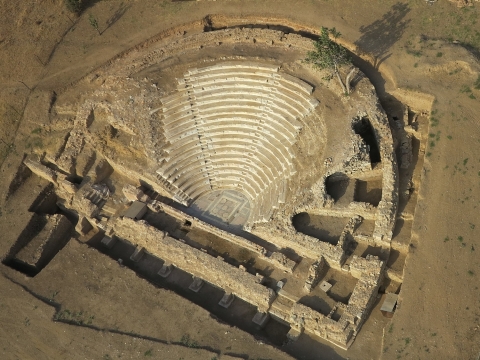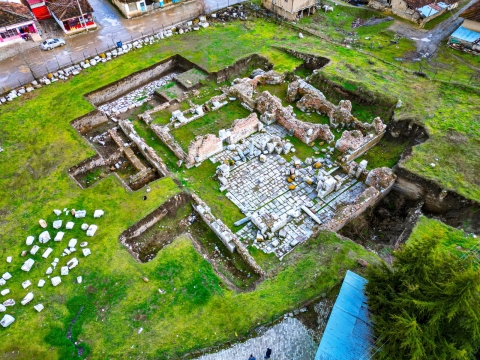OMU-led excavations in Sebastapolis ancient city reveal three new inscriptions
Three inscriptions have been unearthed this year during the ongoing excavations at the ancient city of Sebastapolis in Tokat’s Sulusaray district, carried out under the scientific consultancy of Ondokuz Mayıs University (OMU).
Located 69 kilometers from Tokat city center, the ancient city of Sebastapolis in Sulusaray has an uncertain founding date. During this year’s excavations, three inscriptions were discovered. It is noted that the ancient city, which was included in the province of Cappadocia during the reign of Roman Emperor Trajan (AD 98–117) after being separated from the provinces of Pontus Galatius and Polemoniacus, was one of the five largest cities of the Black Sea region in its time.
Sebastapolis, which had the rare privilege of minting its own coins — an indication of its wealth at the time — is reported to have lost its former significance due to wars, destructions, natural disasters, and the change of trade routes, and was eventually forgotten over time.
Archaeological work at the site began in 1987 under the supervision of Tokat Museum Directorate with preliminary excavations, continued as rescue excavations until 1990, and resumed in 2010 after a hiatus. A large portion of the ancient city, part of which has already been uncovered, lies beneath the modern-day Sulusaray district, which has a population of 3,500. As the expropriation process for the houses located above the site continues, residents of Sulusaray are living intertwined with history.
This year’s excavation phase was conducted with the permission of the Ministry of Culture and Tourism’s General Directorate of Cultural Heritage and Museums, under the direction of the Tokat Museum Directorate, and led by Prof. Dr. Davut Yiğitpaşa and his team from OMU’s Faculty of Humanities and Social Sciences, Department of Archaeology. The excavation, completed three weeks ago, involved 8 academics, 10 students, and 10 workers from various universities.
“A church and tombs from the Byzantine period were found”
Prof. Dr. Yiğitpaşa told Anadolu Agency that they conducted excavations at two different sites in Sebastapolis this year.
He stated that the excavations carried out so far have revealed structures from the Late Roman and Early Byzantine periods, including an apsidal building with a mosaic floor featuring floral, geometric, and figural decorations; a Roman-period wall and bath; and a Byzantine-period church and tombs. “We also uncovered columns, small columns, bases, capitals, pithoi, architectural elements, brick fragments, a marble table leg with a lion’s head motif, coins from various periods, and small artifacts,” he said.
“The church is to be unearthed and opened to tourism”
Explaining that the goal of this year’s excavations was to uncover the architectural structure of the church, Prof. Dr. Yiğitpaşa continued:
“Our goal is to complete the restoration and open it to tourism. During this year’s excavations, we also found small artifacts and three inscriptions. One of them is a tombstone. Our work on them is still ongoing, and we will soon complete their analysis.”
Noting that one of the inscriptions is a tombstone believed to belong to a small child, Yiğitpaşa said:
“It reads ‘the sweetest.’ From this, we understand that a family lost their little child, and such expressions of affection and sorrow were common at that time. It can be described as a Greco-Roman style inscription. Our second inscription is of a commemorative nature. Although one of them has faded letters, it includes the name of a city, but the name is broken and not fully legible. The name ‘Nektaton’ appears, which might indicate an affiliation or personal name.”
Stating that the third inscription mentions Constantine I, Yiğitpaşa added:
“The inscription can be dated to the early fourth century. It contains the phrase ‘Constantine the Invincible,’ which is significant for us.”


















